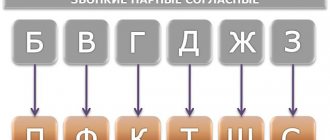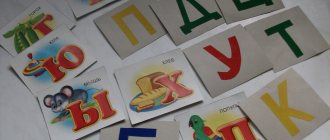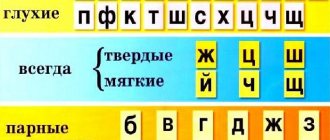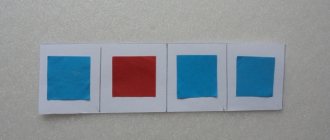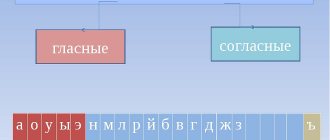- Hard and soft consonants
- Voiced and voiceless consonants
- Hissing and whistling consonants
- Letter and sound Y
The Russian language has 21 consonants and 37 consonant sounds:
| Letter | Sounds | Letter | Sounds | |
| B | [b], [b'] | P | [p], [p'] | |
| IN | [in], [in'] | R | [р], [р'] | |
| G | [g], [g'] | WITH | [s], [s'] | |
| D | [d], [d'] | T | [t], [t'] | |
| AND | [zh], [zh'] | F | [f], [f'] | |
| Z | [z], [z'] | X | [x], [x'] | |
| Y | [th'] | C | [ts] | |
| TO | [k], [k'] | H | [h'] | |
| L | [l], [l'] | Sh | [w] | |
| M | [mm'] | SCH | [sch'] | |
| N | [n], [n'] |
Consonant sounds are hard and soft, voiced and voiceless. The softness of sound in transcription is indicated by [' ].
Consonant sounds based on the participation of voice and noise
Based on the participation of voice and noise, all consonants are divided into sonorant and noisy.
Sonorant consonants are those in which the voice and slight noise are involved in their formation. When these consonants are formed, the glottis is narrowed, the vocal cords are tense and vibrate under the influence of exhaled air. Sonorants in the Russian literary language include: [р], [л], [м], [н] and [р'], [л'], [м'], [н'], [й].
Noisy consonants are those in the formation of which noise predominates over voice. From this point of view, they are divided into voiced noisy sounds, the formation of which is characterized by noise accompanied by voice, and voiceless noisy sounds, which are formed only by noise (the pronunciation of voiceless noisy sounds is determined by the fact that the glottis is open and the vocal cords are not tense and do not vibrate).
Where is the consonant sound formed?
The voiced noisy sounds of the Russian literary language are [b], [b'], [v] and [v'], [d] and [d'], [z] and [z'], [zh], [g] , [g'] (pity, doctor, dawn, nail, storm).
Voiceless noisy ones - [p] and [p'], [f] and [f'], [t] and [t'], [s], [s'], [sh], [sh'], [ts ], [h '], [k], [k '], [x], [x'] (cap, folklore, secret, whisper, noise, buckwheat, quote, store, chic).
Hissing and whistling consonants
The sounds [zh], [w], [h'], [sh'] are called hissing consonant sounds . The sounds [zh] and [sh] are unpaired solids
hissing consonants:
iron
[zhel'ezo],
six
[shest'];
but in combinations zhi, shi
s
is not written .
The combinations zhi, shi
are always written with the letter
and
:
live
here, gara
zhi
,
shi
lo, karanda
shi
.
The sounds [h'] and [h'] are unpaired soft
hissing consonants:
watch
[ch'asy],
pike
[sh'uka],
but in combinations cha, sha
the letter
a
, and in combinations
chu, schu
the letter
y
:
cha
shka
,
square
,
stocking
,
pike
. The sounds [z], [z'], [s], [s'], [ts] are called whistling consonants .
Consonants by place of noise production
According to the place of noise formation, all consonants are divided into labial and lingual, since their formation involves two active organs of speech - lips and tongue: the lower lip plays an active role in the formation of labial consonants, and the tongue plays an active role in the formation of lingual consonants. The active organs of speech act (articulate) in relation to the passive ones - the upper lip, alveoli, teeth, hard palate.
Labial and lingual consonants are divided into a number of smaller groups depending on which passive organs the active ones act on.
Labial consonants are divided into labiolabial and labiodental.
Labiolabial consonants are formed by closing the lower lip with the upper lip. These include: [p], [p'], [b], [b'], [m], [m'].
Labiodental consonants are formed by bringing the lower lip closer to the upper teeth. These include: [f], [f'], [v], [v'].
Lingual consonants are divided into anterior, middle and posterior lingual, depending on which part of the tongue - anterior, middle or posterior - plays an active role in the formation of sound.
Front-lingual consonants are divided into two groups: dental and palatodental.
Paired consonants
When forming dental consonants, the front part of the tongue closes or approaches the upper teeth. These include: [t], [t'], [d], [d'], [s], [s'], [z], [z'], [ts], [n], [n '], [l], [l']. When forming palatodental consonants, the front part of the tongue rises to the front part of the palate and there an obstruction is created in the area of the alveoli. These include: [w], [w], [w'], [w'], [h'], [p], [p'].
the middle lingual , and according to the passive organ the middle palatal , in the Russian language. When it is formed, the middle part of the tongue rises to the middle palate. Rear-lingual , and by the passive organ velar , the sounds [k], [g], [x], [k'], [g'], [x'] are formed by closure ([k, g]) or approach ([x] ) the back of the tongue with a fixed posterior palate.
Article:
In the Russian language, there are 42 speech sounds, or, to use another term, 42 phonemes (from the Greek word phonema, which means “speech sound”).
According to the mechanism of formation, phonemes are divided primarily into vowels and consonants (6 vowels and 36 consonants).
All vowels are characterized by phonation (voice formation), caused by vibration of the vocal cords, and the free passage of exhaled air through the oral cavity.
Consonants are characterized by the formation in the oral cavity of barriers to the path of exhaled air, either in the form of a stop of certain speech organs, or in the form of more or less narrow slits and passages formed by them, or, finally, in the form of a sequential connection of a stop with a gap. When some consonant phonemes are formed, these barriers are combined with phonation; when others are formed, phonation is absent.
The articulatory classification of vowels is built taking into account:
1) participation or non-participation of the lips. In the articulation of the vowels o and u, in addition to the tongue, the lips take an active part, which move forward and round when pronouncing these phonemes. Therefore, the vowels o, u are called labialized (from the Latin labia - lips), and all other vowels are called non-labialized;
2) the degree of elevation of the tongue to the palate (upper, middle and lower elevation);
3) places where the tongue rises (front, middle and back row).
There are six vowel sounds in modern Russian: [a], [o], [u], [e], [i], [s]. The different quality of vowels, which we perceive by ear as different sounds, depends on the volume and shape of the oral cavity during the formation of vowels. The volume and shape of the oral cavity are determined by the movement of the tongue and lips - the active organs of pronunciation. Depending on the movement of the tongue in the horizontal direction (back and forth), vowels are divided into: 1) front vowels [i], [e] (when pronounced, the tongue moves forward, and its tip rests on the lower teeth); 2) middle vowels [ы], [а] (when pronouncing them, the tongue moves slightly back); 3) back vowels [у], [о] (when pronouncing them, the tongue moves back to a greater extent).
Depending on the degree of elevation of the tongue to the palate, i.e., vertical movement of the tongue, the following are distinguished: 1) vowels of the upper rise [i], [s], [y] (when they are formed, the tongue is raised to the palate to the greatest extent); 2) vowels of medium rise [e], [o] (when they are formed, the tongue rises less high to the palate); 3) lower vowels, which include only [a] (when it is formed, the tongue is not raised or raised to a minimal extent, the lower jaw is lowered and the mouth is wide open).
VOWEL CLASSIFICATION
| Participation of lips | Unrounded | Ruined | ||
| Row | Front | Average | Rear | |
| Climb | Upper | AND | Y | U |
| Average | E | ABOUT | ||
| Lower | A |
The articulatory classification of consonants is based on five main features:
1) the presence or absence of vibration of the vocal folds;
2) method of articulation;
3) place of articulation;
4) the presence or absence of additional elevation of the back of the tongue to the hard palate;
5) place of resonance.
Based on the first sign (the presence or absence of vibration of the vocal folds), consonants are divided into:
1) voiced, in the formation of which the tone of the voice is combined with a pronounced noise: b, b', d, d', g, g', c, c', z, z', g, g';
2) sonorous (from the Latin sono - sound), in the formation of which there is almost no noise and the tone of the voice predominates: l, l', p, p', m, m', n, n', and (j),
3) deaf, in the formation of which only noise is involved: p, p', t, t', k.k', f, f', s, s', x, c, ch', sh, shch.
According to the second criterion (according to the method of articulation), consonants are divided into:
1) stops - stop-plosives: b, b', p, p', d, d', t, t', g, g', k, k' and stop-plosives: m, m', n, n ',l,l';
2) fricatives (fricatives): v,v', f,f', z,z', s,s', sh, zh, shch, x,x', and (j),
3) affricates: c, h';
4) trembling: p, p'.
According to the third criterion (place of articulation), consonants are divided into:
1) labial - labiolabial: m, m', p, p', b, b' and labiodental: f, f', v, v'.
2) lingual - lingual-dental: t, t', d, d", n, n', s, s', z, z', c; lingual-alveolar: l,l', p,p'; lingual-anteropalatal: w, g, h, sch; lingual-mid-palatal: k', g', x', 'th (j); posterior lingual (back palatal): g, k, x.
According to the fourth characteristic (by the presence or absence of elevation of the back of the tongue), consonants are divided into:
1) hard: hard pairs of all consonants, except h, sch;
2) soft: soft pairs of all consonants, except sh, zh, c.
According to the fifth criterion (according to the place of resonance), consonants are divided into:
1) nasals: m, m', n, n';
2) oral: all other consonants.
CLASSIFICATION OF CONSONANTS
| Oral or nasal resonating | Degree of voice and noise involvement | Place of education Method of education | Labial | lingual | |||||||||||||
| Labiolabial | Labiodental | Lingual-dental | Lingual-alveolar | Lingual-anteropalatal | Lingual-mid-palatal | Lingual-posterior palatal | |||||||||||
| TV | m | TV | m | TV | m | TV | m | TV | m | TV | m | TV | m | ||||
| Oral Nasal | Noise | Call | Occlusive | B | B' | — | — | D | D' | — | — | — | — | — | G' | G | — |
| Deaf | |||||||||||||||||
| P | P' | — | — | T | T' | — | — | — | — | — | TO' | TO | — | ||||
| Call | Slotted | — | — | IN | IN' | Z | Z' | — | — | AND | — | — | Y | — | — | ||
| Deaf | |||||||||||||||||
| — | — | F | F' | WITH | WITH' | — | — | Sh | SCH | — | X' | X | — | ||||
| Call | Occlusion-slit | — | — | — | — | — | — | — | — | — | — | — | — | — | — | ||
| Deaf | — | — | — | — | C | — | — | — | — | H' | — | — | — | — | |||
| Sonora | Trembling | — | — | — | — | — | — | R | R' | — | — | — | — | — | — | ||
| Connectively-passing | — | — | — | — | — | — | L | L' | — | — | — | — | — | — | |||
| Sonora | Connectively-passing | M | M' | — | — | N | N' | — | — | — | — | — | — | — | — |
Consonants according to the method of noise production
According to the method of noise production, or according to the method of overcoming an obstacle, consonants are divided into stops (plosives), fricatives (frictions), affricates (stop-frictions), stop-passes, and tremors (vibrants).
Closing (plosive) consonants are formed by the complete closure of the organs of pronunciation, and therefore the air, encountering this barrier, tears it apart with force, as a result of which the noise characteristic of these consonants arises.
Stops in the Russian language include: [p], [p.'], [b], [b'], [t], [t'], [d], [d'], [k], [k '], [g], [g'].
Fricative (frictional) consonants are formed by incomplete convergence of the active and passive organs of speech, as a result of which a narrow gap remains between them through which air passes; the noise is generated by the friction of air against the walls of the crack.
Fricative consonants are: [f], [f'], [v], [v'], [s], [s'], [z], [z'], [sh], [zh], [sh '], [th], [x], [x']. Affricates are sounds that are complex in the functioning of the speech organs: at the initial stage of articulation they are formed as stops, that is, by completely closing the speech organs, but at the end of articulation there is not an instantaneous opening of the stop, but its transition into a gap, as in fricatives.
In the Russian literary language there are two affricates: [ts] (t + s) and [ch'] (t' + sh').
Consonants
Close-passive consonants are those whose formation is characterized by complete closure of the speech organs with the simultaneous passage of air through the oral cavity or nasal cavity. Depending on which cavity the air passes through, the occipital passages are divided into nasal and lateral.
Nasal occlusions include: [n], [n'], [m], [m']; to the lateral ones - [l], [l '] (the side of the tongue is adjacent to the upper jaw).
Trembling consonants are consonants, during the formation of which the tip of the tongue either closes or opens with the alveoli during the passage of an air stream (vibrates). Trembling ones in Russian include: [р], [р'].
A more clear description of consonants by method of formation will look like this: Hard and soft consonants, voiced and voiceless consonants, stops and fricatives, and others - the table will show everything.
Table of classification of consonant sounds in Russian
| Method of education | Place of education | ||||||
| Labial | lingual | ||||||
| Labiolabial | Labiodental | Forelingual | Middle language | Rear lingual | |||
| Dental | Anteropalatal | Midpalatal | Postopalatines | ||||
| Occlusive | Oral | [b] [ts] [b'] [n '] | [d] [t] [d'] [t'] | [g] [k] [g'] [k'] | |||
| Nasals | [mm'] | [n] [n'] | |||||
| Slotted | Median | [v] [f] [v '] [f'] | [z] [s] [z'] [s'] | [w] [w] [w'] [w'] | [th] | [x] [x'] | |
| Lateral | [l] [l'] | ||||||
| Africans | [ts] | [h'] | |||||
| Trembling | [r] [r'] | ||||||
The relationship between voice (tone) and noise
All consonant sounds, unlike vowels, contain noise. Some consonants are made entirely of noise, while others are a combination of noise and voice. Depending on the presence or absence of tone, as well as on the degree of noise, the following groups of consonants are distinguished:
- sonorant . They are sometimes also called semivowels, since in them the noise is insignificant, and the tone prevails over the noise: [р], [р'], [л], [л'], [м], [м'], [н], [ n'] and [j];
- noisy _ In them, noise predominates over tone, or there is no tone at all. Accordingly, noisy voiced [b], [b'], [v], [v'], [g], [g'], [d], [d'], [zh], [zh̄'], [ z], [z'] and noisy voiceless consonants: [k], [k'], [p], [p'], [s], [s'], [t], [t'], [f ], [f'], [x], [x'], [ts], [h'], [w], [w̄'].
How to distinguish a hard and soft consonant?
To find out whether a consonant is hard or soft, first pronounce the word and listen to how the sound being studied sounds:
- var [in] - fork [in']
- sign [z] - basket [z']
- catfish [s] - gray [s']
- good [x] - cunning [x']
Let’s also take into account that in written speech the consonants after which the letters are written are soft:
1. “e”, “e”, “i”, “yu”, “i”:
- white [b' e l y']
- motley [p' o s ry y']
- sled [s a n k'i]
- glass [r' u m k a]
- lethargic [v' a l y']
2. The softness of many consonants, except for the unpaired [zh], [sh], [ts], [h'] and [sh'], expresses “b”:
- big [l']
- seven [m']
- tablecloth [t']
- struggle [r'].
Let us take into account that “b”, which is written after the always hard hissing “zh”, “sh”, does not serve to soften them, but to denote feminine nouns of the third declension or verb forms:
- trembling [f]
- gouache [w]
- eat [w]
- cover up [f]
- don't worry [f].
3. Consonants in a combination of several sounds can be soft in sound if the subsequent soft consonant influenced the previous one. This phonetic process of softening a consonant depending on its position in a word is called assimilation based on hardness/softness, or assimilation (Latin assimilatio - “likeness”).
Let's see how consonant sounds influence each other:
- pension [p' e n' s' and j' a]
- bathhouse attendant [b a n' sch' and k]
- donut [p o n' h' and k]
- disease [b a l' e z' n']
- bones [k o s' t'i]
Please note that this phonetic sound of soft consonants is not reflected in written speech.
In accordance with the spelling rule, a soft sign is not written in conjunction with the consonants nch, chk, chn, rshch, rch, etc.
Consolidating knowledge
You can consolidate the material covered by asking your child to compile and fill out such a table. This will also connect motor memory.
A good way to learn to distinguish consonants is to play “dispersing” sounds into “apartments” in a drawn “house”. For example, voiced unpaired ones - in apartments with blue windows, paired ones - with yellow and orange ones, unpaired unpaired ones - with green ones.
It is useful to look for different letters in words. You can give your child examples of words with voiceless consonants, then with voiced consonants, and show that both words can end at the end. You can show how the sorceress Phonetics turns deaf into voiced and vice versa.
Let the sign drawn by the child always hang before his eyes, so that he can periodically return to it and repeat the material. For a child, first of all, it will be a game, but with its help he will study an important topic that will be very useful for him in his studies.
How to teach children to distinguish between hard and soft consonants
The child will learn the difference if he is shown it visually or if he is allowed to feel it through experience. For example, Zaitsev’s cubes with soft consonants are small in size, and with hard consonants they are large. The child makes up words and sees this difference every time.
Also, when analyzing words, you can take pictures that remind the child of something soft and something hard. For example, a pillow and a stone. Hearing a soft sound, the child shows a picture of a pillow. Pictures can be attached to cards or drawn next to letters in a notebook.
Unpaired voiceless consonants
Among the voiceless consonants there are also unpaired ones that do not correlate with voiced consonants.
DefinitionSounds [x], [x'], [ts], [ch'], [sch'] are unpaired voiceless consonants.
The voiceless consonants [x] and [x'] form a pair based on hardness/softness:
- brave - cunning;
- bread - chemistry;
- thin - frail.
The remaining voiceless consonants are unpaired according to all phonetic characteristics. Let us indicate their features:
- sound [ts] is unpaired deaf, unpaired hard;
- the sound [h'] is unpaired deaf, unpaired soft;
- the sound [ш'] is an unpaired deaf sound, an unpaired soft one.
Classification of consonant sounds of the Russian language
Consonant sounds can be hard and soft, dull and voiced. If sounds that according to these characteristics are divided into pairs, there are also unpaired ones. The table will help you understand the overall picture:
| Sound | Voiceless/voiced | Hard/soft | Paired/unpaired |
| b | voiced | solid | doubles |
| V | voiced | solid | doubles |
| G | voiced | solid | doubles |
| d | voiced | solid | doubles |
| and | voiced | solid | doubles |
| h | voiced | solid | doubles |
| To | voiced | solid | doubles |
| l | voiced | solid | doubles |
| m | voiced | solid | doubles |
| n | voiced | solid | doubles |
| P | deaf | solid | doubles |
| R | voiced | solid | doubles |
| With | deaf | solid | doubles |
| T | deaf | solid | doubles |
| f | deaf | solid | doubles |
| X | deaf | solid | doubles |
| ts | voiced | solid | unpaired |
| h | deaf | soft | unpaired |
| w | deaf | solid | doubles |
| sch | deaf | soft | unpaired |
| th | voiced | soft | unpaired |
| b' | voiced | soft | doubles |
| V' | voiced | soft | doubles |
| G' | voiced | soft | doubles |
| d' | voiced | soft | doubles |
| z' | voiced | soft | doubles |
| To' | voiced | soft | doubles |
| l' | voiced | soft | doubles |
| m' | voiced | soft | doubles |
| n' | voiced | soft | doubles |
| P' | deaf | soft | doubles |
| R' | voiced | soft | doubles |
| With' | deaf | soft | doubles |
| T' | deaf | soft | doubles |
| f' | deaf | soft | doubles |
| X' | deaf | soft | doubles |
It is worth understanding in more detail the characteristics that it describes.
So what are voiced and voiceless consonants? This is a characteristic of tonality that indicates whether the vocal cords are used when pronouncing a sound or not. If not, the sound is dull. If yes - sonorous.
Hardness and softness are also pronunciation characteristics. Soft sounds are produced when the middle back of the tongue rises towards the soft palate.
When pronouncing a consonant sound, the vocal tract always narrows, that is, the sound seems to overcome an obstacle.
Accordingly, consonants can be paired in terms of hardness/softness and dullness/voice, and then they will be called paired. Those who do not have such a pair are unpaired.
When to start training?
In fact, the initial stage of learning occurs at an even earlier age, when we teach the baby to distinguish between different sounds. Then we study all the letters of the alphabet, give the concept of vowels and consonants, and teach the child to determine the presence of each of them by ear. Only after this will the baby be able to understand the difference between voiced and deaf and learn to hear them in words.
That is, first you need to develop phonemic hearing in a preschooler - that same ability to isolate individual sounds from speech. How to do it?
- Teach to respond to the sound of rattles by turning your head in their direction.
- We teach a grown-up toddler to listen to nature outside the window: let him close his eyes and describe what he hears (the hum of the wind, the rustling of leaves, the chirping of birds, the noise of cars, barking dogs, etc.).
- We do the same with household appliances at home: let them distinguish the sound of a hairdryer, vacuum cleaner, kettle, refrigerator.
- We play at the zoo: the mother imitates the voices of different animals and birds, and the child guesses them, and then vice versa.
- Let the blindfolded child determine what sounds: a bell, a tambourine, a whistle, etc.
- After he has learned all the letters, you can teach him to identify their presence in words (for example, have him clap or stand up if he hears a given sound).
That is, before studying the voicedness - deafness of consonants, a preschooler must:
- know all the letters of the alphabet, their order, quantity;
- distinguish vowels from consonants;
- have developed phonemic awareness.
All these skills can be developed in a preschooler by the age of 5–6 years.
In order for your baby’s phonemic hearing to develop correctly, try to communicate with him as much as possible, and also make sure that there is no constant background noise around him (a TV that doesn’t turn off, a music player).
Unpaired voiced consonants
In the Russian language there are unpaired consonants, in the formation of which there is more voice than noise. During their formation, air passes through the larynx and the vocal cords tense and vibrate, that is, the voice is involved in their birth.
These sounds differ from voiced consonants in their special sonority, which is why they are called sonorant. This name comes from the Latin word sonorus, which means “sonorous.”
Noise is also present in the formation of sonorant sounds, but to a lesser extent than in voiced consonants.
For example, air passes through the nose and forms the sounds [n] and [n'], and when the lips are closed, the sounds [m] and [m'] are produced.
If the air encounters an obstacle in the form of a tongue and passes into the passage between the edges of the cheeks, then the sounds [l] and [l'] appear.
The tip of the tongue rises to the alveoli and trembles under the escaping stream of air. Then the sounds [p] and [p'] are born.
If you stretch your lips in a smile and press the tip of your tongue against your lower teeth, you will pronounce the sound [th'].
These always voiced sounds, which are pronounced with the participation of voice and noise, do not correlate with any voiceless consonants. They do not have a phonetic pair based on deafness/voice.
Definition The sounds [th], [l], [l'], [m], [m'], [n], [n'], [r], [r'] are unpaired consonants.
They form pairs with each other based on hardness/softness:
- [l] - [l']
- [mm']
- [n] - [n']
- [r] - [r']
Let's listen to how soft and hard sonorous sounds sound in words:
- bank - bathhouse;
- rad - row;
- cape - bowl;
- fishing - lion
And the sound [th'] is unpaired in all characteristics:
- unpaired voiced;
- unpaired soft.
Letter and sound Y
The letter Y (and short) means the sound [th']: paradise [paradise'].
The letter Y is written:
- At the beginning of the words: iodine, yogurt.
- In the middle of words, before consonants: Laika, T-shirt, coffee pot.
- At the end of the words: paradise, may, yours.
The sound [th'] is more common than the letter Y, since it appears in words where there is no letter J, but there are vowels Ya, E, Yu and E. Let's consider in what cases the sound [th'] occurs in words that do not contain the letter Y:
- The vowels Ya, E, Yu and Yo are at the beginning of the word: yama [y'ama].
- The vowels I, E, Yu and E come after the vowels: yours [your'o].
- The vowels Ya, E, Yu and Yo come after the dividing hard sign (Ъ): entry [vy'ezd].
- The vowels Ya, E, Yu and Yo come after the soft separating sign (b): pours [l'y'ot].
- The vowel I comes after the soft separating sign (b): beehives [ul'y'i].
